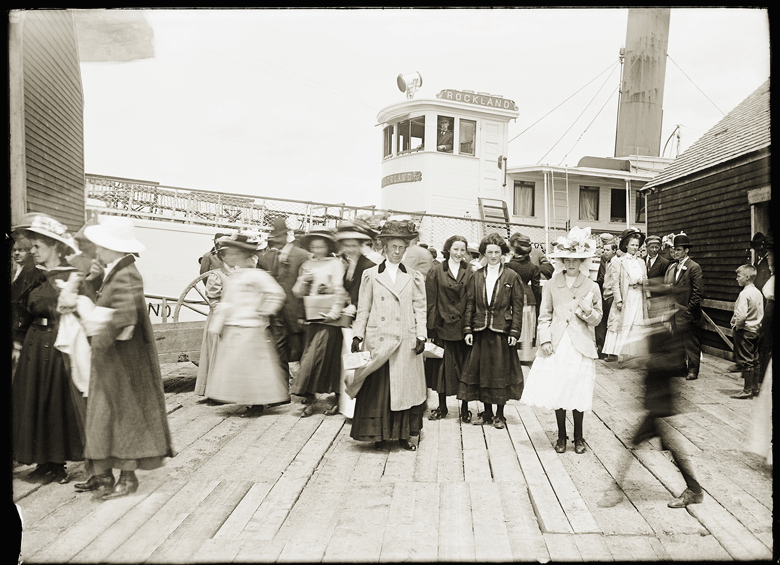Three young women pose nervously for the camera in our image this month. They are dressed for an outing and are holding parcels, maybe containing their lunch. Their chaperon, a spinsterly-looking character, is clearly not amused at the spectacle they are causing on the busy steamboat wharf at Sandy Point in Stockton Springs.
The slow shutter speed blurs the young boy entering the frame on the right along with the people “photobombing” the shot behind the women.
This contrast of stillness and movement gives energy to the photograph and draws the viewer into the scene. One can imagine that they are going to Bangor or Belfast to shop or to have a picnic at Penobscot Park.
She lived for many years with a domineering older sister whose health was poor.
High above the scene, the mustachioed captain of the steamer looks toward the camera through the window of the ship’s cabin. The vessel is the steamship Rockland, not to be confused with the much bigger (274-foot) City of Rockland.
Locally known as “the little Rockland,” she was built in 1883 in Boston with materials leftover from the SS PENOBSCOT. At 98.9 feet and 135 gross tons, she was nimble enough to service the smaller wharves along the Penobscot River and the Blue Hill line.

This lively scene was captured by young Harriet Hichborn of Stockton Springs. Harriet was born in that town into a large and notable family in late August of 1869. Her father, the accomplished shipbuilder Hon. Nathan Griffin Hichborn, was descended from Robert Hichborn, one of the original Cape Jellison settlers and a cousin to Paul Revere.
She grew up in a large house in Stockton Village, which most recently has been the fine dining restaurant The Hichborn. Harrriet’s photographs capture Stockton Springs at a time of great growth as the railroad connected Cape Jellison with Searsport and the building of the great wharf in Stockton Harbor. She lived for many years with a domineering older sister whose health was poor. Her darkroom was her sanctuary. She suffered from extreme depression that some blamed on the exposure to the photography chemicals.
She ultimately took her life in December of 1923, at the age of 54, by jumping from the Brewer Bridge. The Waldo Hancock bridge wouldn’t be built for another 10 years.
The Harriet Hichborn Collection consists of 391 glass plate negatives. It was donated to the Penobscot Marine Museum in 2015 by the Stockton Historical Society.
The photographs were researched and described by Stockton historian Kathy Harrison. The collection is one of four significant collections by female photographers which are part of the msueum’s photo archive and available for exploration online.
Kevin Johnson is photo archivist at the Penobscot Marine Museum in Searsport. For more information about the museum’s exhibits and its extensive maritime photography collection, see PenobscotMarineMuseum.org.





